Side A - Particles and Radiation
1/48
Earn XP
Description and Tags
Name | Mastery | Learn | Test | Matching | Spaced |
|---|
No study sessions yet.
49 Terms
Define an isotope
An atom of the same element with the same number of protons but a different number of neutrons
What are the 2 types of fundamental particle
Quarks and Leptons
What are quarks types
Up (u) + Down (d)
strange (s)
What is the proton number
Number of protons in nucleus of an atom
Can be called atomic number
Smallest number of an element
Also equal to No. of electrons atom has
What is the nucleon number
Number of protons in an atom + number of neutrons in an atom in atoms nucleus
Also called mass number
What is specific charge
= charge of particle/mass of particle
Measured in coulombs per kg (Ckg-1)
The greater the charge the greater the force
The greater the mass the less the force accelerates particles
Charge of a proton
1.60×10^-19 C
Charge of electron
-1.60×10^-19 C
Charge of neutron
0 charge
Define strong nuclear force
is attractive between 0.5-3.0fm (atom becomes unstable if not in range)
is repulsive below 0.5f
hold protons and neutrons together
Exchanged through pion
Define weak nuclear force
Exchanged by W bosons
Used in beta+ (proton-neutron) and beta- decay (neutron-proton)
affects unstable nuclei
Define electromagnetic force
Exchanged by virtual photon
Used in gamma radiation
What is Alpha radiation
Occurring in large nuclei
Alpha particle is a helium atom
Proton No. decrease by 2
Nucleon No. decrease by 4
What is Beta radiation
Occurs in nuclei with too many neutrons
Beta particle is a fast moving electron
Proton No. increases by 1
Neutron decays into proton + electron + electron antineutrino
What is gamma radiation
EM radiation emitted from unstable nucleus
Occurs after alpha or beta decay, as nucleus has excess energy
What is EM radiation
Emitted when charged particles loose energy
Consists of electric and magnetic field waves which are at right angles to each other
What is the wave equation
Wave speed (c)(3.00×10^8 ms-1) = frequency (f -Hz)/ Wavelength (λ - m)
What is a photon
A discrete packet of waves
each photon carries energy that relates to its frequency (the higher the frequency the more energy)
EM force exchange particle, emitted when a charged particle looses energy
Photon energy equation
Photon energy (E) = Planks constant (6.63×10^-34 Js) x Frequency (f - Hz)
E = h x c/λ
Define antimatter and its components
All particles have corresponding antimatter
They have same mass but opposite charge (if particle is charged)
If they collide with corresponding particle annihilation occurs
If photon directed at them, pair production occurs
e.g. antiproton, positron, antineutrino
Define Annihilation
particle and corresponding antiparticle colliding
Mass and kinetic energy converted to 2 gamma photons with the same frequency
They move off in opposite directions
They conserve momentum
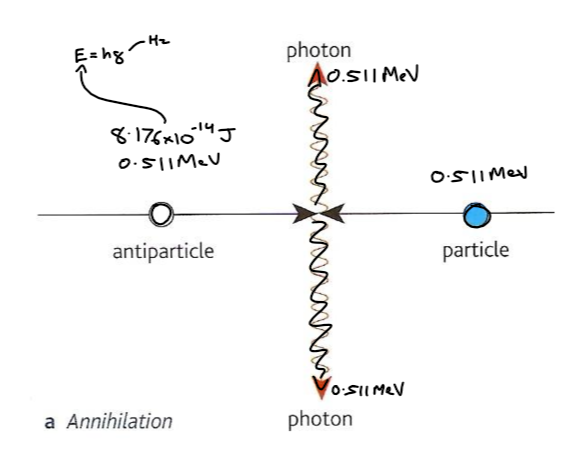
Define pair production
photon is directed at nucleus or electron
corresponding particle and antiparticle pair produces
photon must have minimum freq and energy
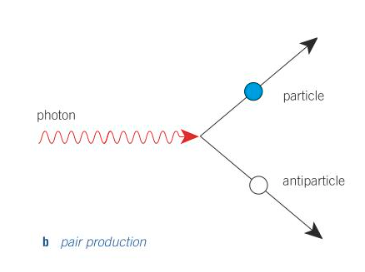
MeV to Joules
1MeV = 1.60×10^-13J
Min energy of photon
E = hf = hc/λ
E - energy
h - planks constant
f - frequency
λ - wavelength
c - speed
Particle interactions
like charges repel
opposite charges attract
e.g. EM force between protons - photon transfers momentum so protons repel
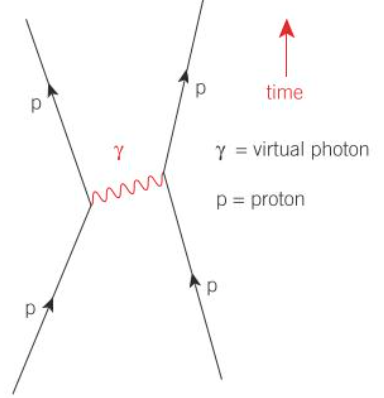
W boson characteristics
have non-0 rest mass
short range (0.001fm)
can be positive or negative
B- decay
Neutron becomes proton
W- becomes B- (e-) and electron anti-neutrino
in neutron rich nucleus
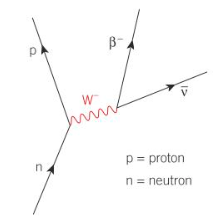
B+ decay
Proton becomes neutron
W+ becomes B+ (e+) and electron neutrino
in proton rich nucleus
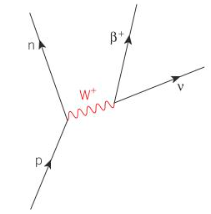
Electron capture
proton in proton rich nucleus turning to neutron when interacting with inner-shell electron with weak interaction
proton becomes neutron
W+ boson makes e- into ve
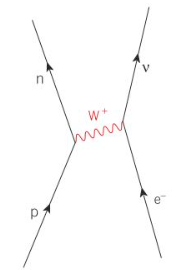
What is a muon
heavy electron - μ
type of lepton
negatively charged
higher rest mass than electron - decays into electron+antineutrino/positron+neutrino
What is a pion
π meson
positive or negative or neutral charge
heavier rest mass than muon - decays into muon+antineutrino/antimuon+neutrino if charged, if not charged decays into high energy photons
What is a Kaon
K meson
positive or negative or neutral charge
rest mass larger than pion - decays into pions/muon+antineutrino/antimuon+neutrino
have a strangeness
formed through strong interaction, decay through weak interaction
What is a hadron
particles and antiparticles that interact through strong interaction
e.g. proton, neutron, pion, kaon
made up of quarks
What is a lepton
fundamental particle
interacts though all interactions but strong interaction
e.g. muons, electrons, neutrinos
leptons + antileptons can interact to produce hadrons
Undergoing weak interaction leptons change into other leptons
Lepton No. must be conserved in interactions
Rest energy equation
rest energy = total energy before - kinetic energy of products
What is a baryon
Hadron made up of 3 quarks/antiquarks
Decay into protons
e.g. protons and neutrons
What is a Meson
Hardon made up of quark antiquark combination
Dont decay into protons
e.g. kaons and pions
Neutrinos
Travel near light speed
Travel whilst interacting very little with other particles
each non-neutrino lepton has a neutrino and antineutrino
e.g. muon neutrino and electron neutrino
Produced in decay
Strangeness
from strange quarks
can be conserved by + or - one in weak interaction
Meson combinations
Bottom and top row kaons with strangeness
Pions have no s
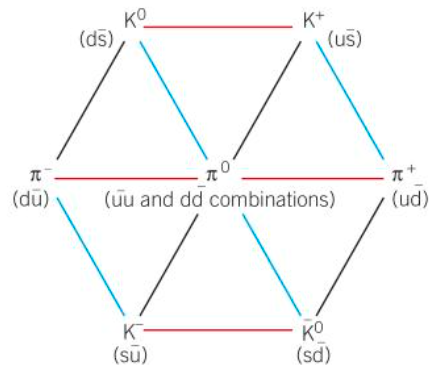
Baryon combinations
Proton - uud
neutron - udd
what is conserved in particle interactions
Energy (including rest energy) and charge- all interaction
Lepton No. - all interaction
strangeness - in strong interaction
Baryon No. - all interaction
Photoelectric effect
Electrons emitting from surface of metal when EM radiation above threshold frequency is directed at said metal
No. of electron emitted is proportional of incident ray intensity, if freq is above threshold
Each electron at surface gains energy from waves no matter how many waves arrive each second
Proves that light can also be particle (wave-particle duality)
Threshold frequency
min freq for photoelectric effect to take place
changes depending on metal
Photoelectric effect explanation
When light meets surface of metal, each electron absorbs single photon and gains energy of hf
If energy gained is more than work function (ϕ) an electron can leave the metal surface
Any excess energy gained by photoelectron is converted to Ek
Work Function
Min energy electron needs to gain to escape metal surface
Max Ek of electron emitted in photoelectric effect equation
Ek(max) = hf - ϕ
Threshold freq equation
f (min) = ϕ/h
Stopping potential
Min energy needed to stop photoelectric emission, where Ek(max) of emitted electron becomes 0, so each electron has to do extra work to leave metal surface
Ek(max = e x Vs (stopping potential)